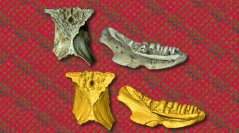

 Geodiversitas
43 (9) - Pages 219-293
Geodiversitas
43 (9) - Pages 219-293A long-forgotten, old collection of lizards from the Phosphorites du Quercy in southern France, housed in the Naturhistorisches Museum in Vienna (NHMW), is described in detail in this paper. The material, consisting of several almost complete cranial and postcranial disarticulated elements, originates from different, imprecisely known localities. Nevertheless, the completeness and exceptional preservation of many of these specimens permitted the identification of new taxa, as well as the recognition and better understanding of novel anatomical features of previously described forms. Among the specimens, the material described herein and referred to Cadurcogekko cf. piveteaui ranks among the most complete cranial remains of Paleogene gekkotans. A clarification about the type material of the previously described species Cadurcogekko verus Bolet, Daza, Augé & Bauer, 2015, is provided. A new species of lacertids is established, Pseudeumeces kyrillomethodicus n. sp. Additional, large lacertid material is referred to Mediolacerta Augé, 2005, representing also the largest one attributable to this genus. At least two glyptosaurine taxa are present in this collection, among which, the genus Paraplacosauriops Augé & Sullivan, 2006, is represented by exceptional cranial material, referred to Paraplacosauriops quercyi (Filhol, 1882). The completeness of the cranial material of Paraplacosauriops permits a more comprehensive understanding of its maxillary and mandibular anatomy. A detailed documentation of cranial and postcranial material for the genus Palaeovaranus Zittel, 1887-1890, is conducted. The new maxilla described herein allows a better understanding of the peculiar maxillary features of the genus Palaeovaranus. Emended diagnoses are provided for the genus Palaeovaranus and its type species Palaeovaranus cayluxi Zittel, 1887-1890. The parietal morphology of Palaeovaranus is analyzed in detail and intraspecific variation in this element is assessed. A new species of Palaeovaranus is established, Palaeovaranus lismonimenos n. sp., on the basis of an almost complete parietal that can be differentiated from that of Palaeovaranus cayluxi on the basis of a number of distinctive features. Additional, previously published specimens from Quercy are here referred to Palaeovaranus lismonimenos n. sp., representing younger individuals of this species, and photographs of this material is provided for the first time. The diversity of platynotans in the Paleogene of Europe is discussed and their distinction on the basis of parietal morphology is provided. According to the new emended diagnosis for Palaeovaranus, the genus Melanosauroides Kuhn, 1940, is revalidated herein to accommodate Melanosauroides giganteus Kuhn, 1940, from the late early or middle Eocene of Geiseltal, Germany. So far, Melanosauroides giganteus is solely known from its type area in Geiseltal, and all previously supposed occurrences of this taxon in Quercy are discarded. Abundant anguimorph vertebral material is referred to Placosaurus sp., Melanosaurini indet., Anguinae indet., Palaeovaranus sp., Saniwa sp., and Anguimorpha indet., although it is highlighted that certain of these referrals should be taken into consideration with caution. Especially, the problem of certain large isolated lizard vertebrae from Quercy is addressed; a tentative, potential distinction between vertebrae of the genera Palaeovaranus and Placosaurus Gervais, 1848-1852, is suggested, although admittedly only articulated skeletons of these genera may confirm or refute such taxonomic referrals. The importance of fossil squamates from the area of the Phosphorites du Quercy is highlighted. Detailed figuring of the specimens is provided through the means of both photography and micro-CT scanning, with 3D models of the most significant material also presented. This is the first time that micro-CT scanning is conducted on fossil squamates from Quercy. The many figures provided in this paper may serve as a pictorial key guide for fossil lizards from the Paleogene of Europe.
Squamata, lizards, Quercy, Paleogene, micro-CT scanning, skeletal anatomy, new species